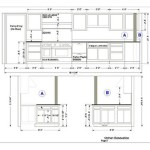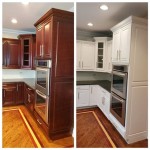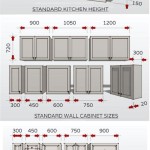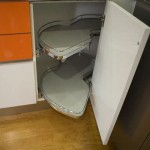Inside Kitchen Cabinet Ideas: Maximizing Space and Organization
Kitchen cabinets, often the unsung heroes of culinary spaces, play a crucial role in maintaining organization and efficiency. Optimizing the interior of these cabinets can significantly impact the functionality of the kitchen, transforming it from a source of frustration to a haven of culinary creativity. Effective cabinet organization involves a combination of strategic planning, appropriate storage solutions, and a commitment to maintaining order. This article will explore various ideas and techniques for maximizing space and enhancing organization within kitchen cabinets.
Pull-Out Shelves and Drawers
Traditional kitchen cabinets often feature fixed shelves, which can make accessing items at the back challenging. Pull-out shelves and drawers offer a solution to this problem, allowing for easy access to all items stored within the cabinet. These mechanisms glide smoothly, bringing the contents of the back of the cabinet forward. Pull-out shelves are particularly useful for storing pots, pans, and large appliances, while pull-out drawers are ideal for smaller items like spices, containers, and utensils. The installation of pull-out systems can be implemented in existing cabinets or incorporated into new kitchen designs.
When selecting pull-out shelves and drawers, it is essential to consider the weight capacity and the quality of the hardware. Opting for heavy-duty options with robust glides ensures that the shelves can withstand the weight of the stored items without buckling or becoming difficult to operate. Furthermore, the depth and width of the pull-out system should be carefully measured to ensure a proper fit within the existing cabinet dimensions. Professional installation may be required, especially in older homes where cabinet structures could be less uniform.
Beyond the standard pull-out shelf, specialized variations exist to cater to specific storage needs. For instance, pull-out spice racks, designed to accommodate multiple spice jars in an organized manner, can be installed in narrow cabinets or alongside the stove for convenient access during cooking. Similarly, pull-out trash and recycling bins offer a discreet and hygienic solution for waste management, keeping unsightly bins hidden from view while remaining easily accessible.
The use of dividers within pull-out drawers is crucial for maintaining organization. Dividers can be adjusted to create compartments of varying sizes, allowing for the segregation of different types of items. This prevents items from shifting and becoming disorganized, making it easier to locate what is needed. Consider using clear acrylic dividers for visibility or wooden dividers for a more cohesive aesthetic.
Vertical Dividers and Tray Organizers
Vertical space within kitchen cabinets is often underutilized. Installing vertical dividers and tray organizers allows for efficient storage of items like baking sheets, cutting boards, and platters. These items, which are typically flat and wide, can be difficult to store horizontally without taking up significant space. Vertical dividers create individual slots for each item, preventing them from stacking on top of each other and becoming difficult to retrieve.
The installation of vertical dividers can be accomplished in several ways. Pre-made vertical dividers are available in various sizes and materials, often featuring adjustable slots to accommodate different thicknesses of items. Alternatively, custom dividers can be constructed from wood or metal to perfectly fit the dimensions of the cabinet and the specific storage needs. The use of non-slip materials on the dividers can further enhance stability and prevent items from sliding out.
Tray organizers are specifically designed to hold trays and baking sheets in a vertical position. These organizers typically consist of a series of vertical slots or dividers mounted within the cabinet. Some models are adjustable, allowing for customization of the slot widths to accommodate different sizes of trays. The use of tray organizers can significantly reduce clutter and make it easier to access baking equipment without having to rummage through a stack of items.
In addition to storing trays and baking sheets, vertical dividers can also be used to organize lids for pots and pans. Lids can be difficult to store efficiently, often taking up more space than the pots themselves. By placing lids vertically in dividers, they can be kept organized and readily accessible. Consider labeling the dividers to indicate which lid belongs to which pot, further enhancing organization.
Door Organizers and Spice Racks
The inside of kitchen cabinet doors presents an often-overlooked opportunity for storage. Door organizers and spice racks can be attached to the inside of cabinet doors to provide additional storage space for a variety of items. These organizers are particularly useful for storing frequently used items like spices, cleaning supplies, or small kitchen gadgets. By utilizing the door space, the interior of the cabinet remains less cluttered, improving overall organization.
Spice racks designed for door mounting are available in various sizes and styles. Some models feature multiple shelves or tiers, while others consist of individual clips or holders for each spice jar. When selecting a door-mounted spice rack, it is crucial to consider the weight capacity of the door and the size of the spice jars to be stored. Overloading the door can cause it to sag or become damaged over time. It's also important to remember to leave enough clearance for the shelves so that other items can be stored on the primary shelf as well and that the door will fully shut.
Door organizers can also be used to store cleaning supplies, such as spray bottles, sponges, and dish soap. These organizers typically feature hooks or compartments to hold the supplies securely. Storing cleaning supplies on the door can free up valuable space under the sink, keeping the interior of the cabinet more organized. Using a door-mounted organizer can also prevent leaks and spills from damaging the cabinet floor.
Installation of door organizers typically involves attaching the organizer to the door using screws or adhesive strips. It is crucial to ensure that the organizer is securely mounted to prevent it from falling off or damaging the door. Consider using screws with a wide head to distribute the weight of the stored items evenly. If using adhesive strips, ensure that the strips are rated for the weight of the organizer and the stored items. Also, measure the depth of the interior items to be stored to ensure that the door can still be closed with the organizer in place.
Lazy Susans and Corner Cabinet Solutions
Corner cabinets often present a storage challenge due to their awkward shape and limited accessibility. Lazy Susans and other corner cabinet solutions offer a way to overcome this challenge by providing rotating shelves that allow for easy access to all items stored within the cabinet. These solutions maximize the use of corner space, preventing items from becoming lost or forgotten in the back of the cabinet.
Lazy Susans are rotating shelves that can be installed in corner cabinets to provide easy access to stored items. These shelves typically consist of two or more tiers that rotate independently, allowing for efficient storage and retrieval of items. Lazy Susans are available in various sizes and materials, including wood, plastic, and metal. When selecting a Lazy Susan, it's important to measure the interior dimensions of the corner cabinet to ensure a proper fit. The weight capacity of the Lazy Susan should also be considered, especially if storing heavy items like pots and pans.
Beyond standard Lazy Susans, alternative corner cabinet solutions exist to cater to specific storage needs. Blind corner pull-outs, for example, feature shelves that extend out from the cabinet, allowing for easy access to items stored in the blind corner. These pull-outs are particularly useful for storing large or bulky items that would be difficult to access with a traditional Lazy Susan.
Another corner cabinet solution is the corner drawer system. This system consists of a series of triangular drawers that fit into the corner cabinet, maximizing the use of space. Corner drawers can be customized to accommodate various storage needs, such as storing spices, utensils, or cookware. The use of corner drawers can significantly improve the organization and accessibility of corner cabinets.
When installing corner cabinet solutions, it is essential to follow the manufacturer's instructions carefully. Proper installation ensures that the system operates smoothly and efficiently. Consider hiring a professional installer, especially if the corner cabinet is particularly difficult to access or if the installation requires modifications to the cabinet structure.
Containerization and Labeling
Effective organization extends beyond the placement of storage solutions within cabinets; it encompasses the method of storing individual items. Containerization and labeling are fundamental to maintaining an organized kitchen and maximizing space within cabinets. Utilizing uniform containers and clear labeling systems promotes efficiency and reduces clutter.
Employing matching containers, typically made of clear plastic or glass, allows for efficient stacking and optimal space utilization. These containers should be airtight to ensure the freshness of stored food items. Selecting a variety of sizes allows for the storage of different quantities of food, from small portions of spices to larger quantities of grains or flour. The uniform shape of the containers simplifies the visual organization of the cabinet, making it easier to locate and retrieve items.
Labeling containers is crucial for identifying the contents and expiration dates of stored food items. Clear, legible labels, either handwritten or printed, should be affixed to each container. Information such as the name of the item, the date it was stored, and any relevant expiration dates should be included on the label. These labels can be easily removed and replaced as needed, ensuring that the containers remain organized and up-to-date.
Beyond food storage, containerization and labeling can be applied to other areas of the kitchen, such as organizing cleaning supplies or kitchen gadgets. Clear plastic bins can be used to store smaller items, preventing them from becoming scattered and disorganized. Labeling these bins allows for quick identification of the contents without having to rummage through each container.
The practice of containerization and labeling encourages a more mindful approach to storage, prompting individuals to regularly assess and declutter their cabinets. Discarding expired or unused items helps to prevent clutter from accumulating and ensures that only necessary items are stored within the cabinets. This ongoing process of organization and decluttering is essential for maintaining an efficient and functional kitchen.
Lighting Solutions for Cabinets
Adequate lighting within kitchen cabinets is often overlooked, yet it plays a critical role in enhancing visibility and functionality. Proper lighting can transform a dark and cluttered cabinet into a well-lit and easily navigable space. Various lighting solutions are available, each offering unique benefits in terms of illumination, energy efficiency, and ease of installation.
Under-cabinet lighting, typically installed beneath the upper cabinets, provides focused illumination on the countertops. While primarily designed to illuminate the workspace, under-cabinet lighting can also indirectly enhance the interior lighting of the cabinets, especially those located directly above the countertops. This lighting can be achieved through solutions like LED strips, puck lights, or linear fixtures. LED lights are an energy-efficient choice, offering bright illumination with minimal heat output.
In-cabinet lighting provides direct illumination within the cabinet itself. These lights can be installed on the inside of the cabinet doors, on the underside of the shelves, or on the back wall of the cabinet. Options include battery-operated LED puck lights, which are easy to install and require no wiring, or hardwired LED strip lights, which offer a more permanent and integrated lighting solution. Motion-activated lights are particularly convenient, automatically turning on when the cabinet door is opened and off when it is closed.
When selecting lighting solutions for kitchen cabinets, it is crucial to consider the color temperature of the light. Warm white light (2700-3000K) provides a soft and inviting ambiance, while cool white light (4000-5000K) offers a brighter and more focused illumination. The choice of color temperature depends on personal preference and the overall aesthetic of the kitchen.
Proper lighting not only enhances visibility but also contributes to the overall organization of the kitchen. Well-lit cabinets make it easier to locate items quickly, reducing the need to rummage through cluttered shelves. This improved visibility can encourage more frequent use of stored items, preventing them from becoming forgotten or expired.

15 Stunning Kitchen Cabinet Designs In Singapore With 5 Essential Tips

Kitchen Wardrobe Cabinet Ideas For Your Home Designcafe

15 Unique Kitchen Drawer Design Ideas For Clever Storage Beautiful Homes
:strip_icc()/121035540_331772381251072_3717720175166945340_n-ae336a3237ca44c6bdddd093c7d1eb97.jpg?strip=all)
21 Kitchen Cabinet Organization Ideas You Need To Try

25 Best Ideas For How To Organize Kitchen Cabinets

Get Inspired By Deborah Von Donop S Strategies For A Kitchen That Functional And Beautiful Dvd Interior Design

How To Organize Your Kitchen Cabinets And Pantry Feed Me Phoebe

Kitchen Tall Unit Design Cabinet Ideas By Livspace

Home Bunch S Top 5 Kitchen Design Ideas Interior Cabinet Clever Storage

Kitchen Cabinet Decor Ideas For Your Home Design Cafe
Related Posts








